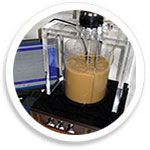 Respirometry
Respirometry
“Taking the pulse and understanding the Heart Rhythm …”
Thorough respirometric analysis is like a human “ECG-load test”. It quantifies the powers and the capabilities of the activated sludge during performance when challenged with substrate(s). Hence its importance and relevance hardly can be underrated. The information obtained from this can be very useful in the following:
- “Facts and Figures”- based understanding and insight in your plant, rather then having to guess (and to be sorry…)
- Bulking sludge problems
- Plant capacity evaluation: “Can this sludge have more, and how much more? …”
- Bringing evidence in litigations and/or several types of discussions
- Quantified degradation rates and -parameters for specific, and sometimes “tricky” compounds
- Denitrification rate estimation with influent, special chemicals, etc.
- Toxicity or inhibition tests with new (partial) influents and determination of the inhibition type (competitive, non-competitive, uncompetitive or mixed type inhibition) on both the heterotrophic and the autotrophic metabolism [and even differentiation between AOB (Ammonium Oxidising Bacteria) and NOB (Nitrite Oxidising Bacteria)]
- Adaptation tests: evaluation of short and long term effects of new influent compounds
- Acceptance testing of suspected (partial) influents or waste streams…
- parameter input for modelling exercises (dynamic wastewater treatment models)
- Design of special units (e.g. aerobic selector design)
- Scientific research
- …
Pulse type respirometry is an excellent way to study the dynamics of the activated sludge COD- and NH4-conversion/interaction. The thus obtained experimental data can be interpreted with specific software for biokinetic parameter estimation; called MBPES (“Model Based Parameter EStimation”). Via a dynamic simulation (ASM1 -based), the following biokinetic parameter values or information can be estimated:
- The kinetic model type giving the best experimental fit (Multiple Monod, Haldane,…)
- Maximum growth rate (µmax, [dim: 1/min], for heterotrophs and autotrophs)
- Substrate affinity coefficient or half-saturation coefficient (KS, [dim: mg COD or N /L])
- Oxygen affinity constant (KDO, [dim: mg O2/L])
- Heterotrophic Yield coefficient (YH, [dim: -])
- Respiration profile: OUR(t) [dim: mg O2/L.min]
- Stoichiometric check on nitrification, and eventual on NOB activity limitations
- A COD-differentiation can be made into readily biodegradable COD (rbCOD) and more slowly biodegradable COD (sbCOD)
- …..
Contact us for a respirometer rental– and training program, for further data processing and interpretation of the results and for assistance with the experimental setup in order to get better and more meaningful experiments and hence results from your efforts.

Haldane Kinetics

Double Monod (COD- and N) Kinetics

Kinetics with tailing (COD only)
Need Advice ?
If you own a specific WWT problem or, if you have a pressing question; then do start a conversation with us and get some unbiased and free advice!


